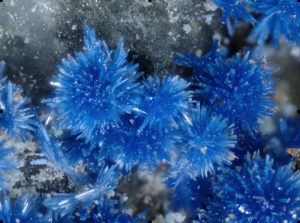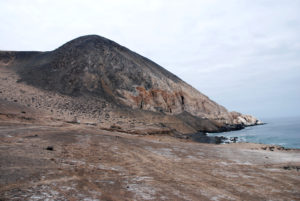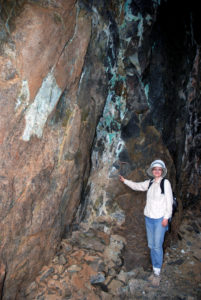Intertwined Discovery
18 October 2017New carbon mineral #11 has strong family ties
The newly discovered – and exquisitely beautiful – mineral triazolite is intricately linked to another mineral, chanabyaite. And, interestingly, like another recently discovered carbon mineral tinnuculite, triazolite was discovered in a guano deposit.
The path to formal acceptance of triazolite as a mineral began in 2008 when German mineral dealer Gunnar Färber first collected specimens containing triazolite and chanabayaite (the product of natural alteration of triazolite) in a guano deposit situated on the lower part of the steep northern slope of Pabellón de Pica Mountain, 1.5 km south of Chanabaya village, Iquique Province, Tarapacá Region, Chile. The Guanay cormorant (Phalacrocorax bougainvillei) is the most likely producer of this Chilean guano. This guano deposit is unique because it is in contact with chalcopyrite-bearing gabbro, a dark, coarse-grained rock with crystalline texture that forms deep below the Earth’s surface. Such contact allows numerous organic minerals of copper to form, and provides a suitable substrate upon which crystals of triazolite can grow.
The process was reignited in 2012, when another German mineral collector Gerhard Möhn collected similar material from the same locality in 2012. He shared these specimens with Dr. Nikita Chukanov (Russian Academy of Sciences, Institute of Problems of Chemical Physics), one of the world’s leading mineralogists, whose collection of 4400 mineral species has yielded his identification of more than 200 new minerals approved by the International Mineralogical Association Commission on New Minerals, Nomenclature and Classification (IMA CNMNC).
Initially Chukanov did not distinguish between the inter-related minerals triazolite and chanabayaite. Rather, his research and data focused on chanabayaite, the altered form of triazolite. The IMA CNMNC declared chanabayaite a new mineral in 2013, and later in 2015 designated it as “mineral of the year.”
Chukanov and his colleagues, Natalia V. Zubkova, Gerhard Möhn, Igor V. Pekov, Dmitriy I. Belakovskiy, Konstantin V. Van, Sergey N. Britvin and Dmitry Y. Pushcharovsky, however, continued their investigation into this inter-related mineral duo. They conducted experiments using a complex series of methods including electron microprobe and chromatographic analyses, powder and single-crystal diffraction, crystal structure refinement, IR spectroscopy, and optical measurements to determine that the specimen contained two related minerals: chanabayaite and its precursor “triazolite.” Triazolite was officially designated a mineral species in 2017.
Chukanov credits Gerhard Möhn with helping advance the discoveries of chanabayaite, triazolite, and numerous other new minerals from Chilean and German localities. “Möhn did the “heavy lifting” of not only collecting these minerals, but also contributed their preliminary chemical analyses,” said Chukanov. “Without Möhn’s curiosity, tenacity, and willingness to share samples, these minerals would likely still be a mystery.”
Chukanov has published several books on minerals, including two monographs on infrared spectroscopy of minerals:
Chukanov, N.V. “Infrared spectra of mineral species: Extended library.” Springer-Verlag GmbH, Dordrecht–Heidelberg–New York–London, 2014. 1716 pp.
Chukanov N.V., Chervonnyi A.D. “Infrared Spectroscopy of Minerals and Related Compounds.” Springer: Cham–Heidelberg– Dordrecht–New York–London, 2016. 1109 pp.




